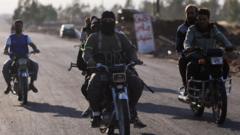In a significant escalation of violence, Israel executed a series of airstrikes in the southern suburbs of Beirut, focusing on locations believed to be involved in drone production by the militant group Hezbollah. This bombardment represents one of the most substantial military actions in the area since the cease-fire agreement, mediated by the Biden administration, was put in place after a devastating conflict in Lebanon.
Israel Launches Airstrikes in Southern Beirut Targeting Hezbollah Drone Facilities

Israel Launches Airstrikes in Southern Beirut Targeting Hezbollah Drone Facilities
Intensified military actions mark a deterioration of the U.S.-brokered cease-fire amid rising tensions in the region.
On June 5, 2025, Israel undertook extensive airstrikes aimed at underground facilities purportedly operated by Hezbollah for drone manufacturing. These strikes, which targeted densely populated neighborhoods known as Dahiya, marked a serious breach of the cease-fire that had been established in November, intended to bring an end to Lebanon's most severe war in decades.
The Israeli military defended its actions, alleging that Hezbollah was intentionally situating these drone facilities within civilian locales, constituting a breach of the cease-fire terms. The agreement mandated Hezbollah's disarming in addition to an Israeli withdrawal from southern Lebanon, where the militant group maintained considerable influence prior to the conflict.
Both Lebanon and Israel have leveled accusations against one another for not complying fully with the cease-fire stipulations. Before the airstrike campaign began, the Israeli military instructed residents in three Dahiya neighborhoods, where Hezbollah holds considerable power, to evacuate from specific buildings highlighted in a map shared on social media. In response to the impending strikes, the Lebanese military sought to conduct inspections of the identified sites and reached out to a U.S.-led monitoring committee established to oversee the cease-fire.
This renewed violence underscores the fragility of the peace agreement and highlights the dire need for renewed diplomatic efforts to stabilize the region amid ongoing tensions.
The Israeli military defended its actions, alleging that Hezbollah was intentionally situating these drone facilities within civilian locales, constituting a breach of the cease-fire terms. The agreement mandated Hezbollah's disarming in addition to an Israeli withdrawal from southern Lebanon, where the militant group maintained considerable influence prior to the conflict.
Both Lebanon and Israel have leveled accusations against one another for not complying fully with the cease-fire stipulations. Before the airstrike campaign began, the Israeli military instructed residents in three Dahiya neighborhoods, where Hezbollah holds considerable power, to evacuate from specific buildings highlighted in a map shared on social media. In response to the impending strikes, the Lebanese military sought to conduct inspections of the identified sites and reached out to a U.S.-led monitoring committee established to oversee the cease-fire.
This renewed violence underscores the fragility of the peace agreement and highlights the dire need for renewed diplomatic efforts to stabilize the region amid ongoing tensions.





















